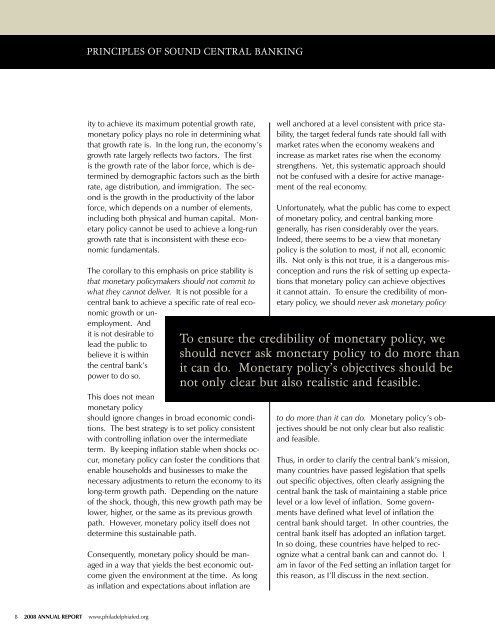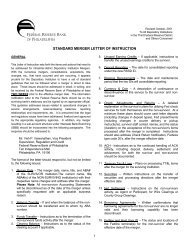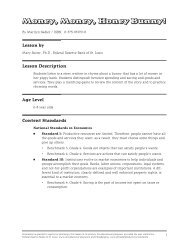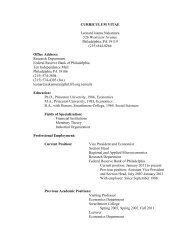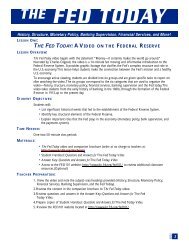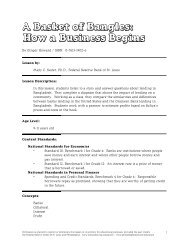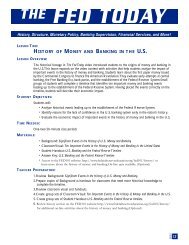Complete 2008 Annual Report - Federal Reserve Bank of Philadelphia
Complete 2008 Annual Report - Federal Reserve Bank of Philadelphia
Complete 2008 Annual Report - Federal Reserve Bank of Philadelphia
Create successful ePaper yourself
Turn your PDF publications into a flip-book with our unique Google optimized e-Paper software.
Principles <strong>of</strong> Sound Central <strong>Bank</strong>ing<br />
ity to achieve its maximum potential growth rate,<br />
monetary policy plays no role in determining what<br />
that growth rate is. In the long run, the economy’s<br />
growth rate largely reflects two factors. The first<br />
is the growth rate <strong>of</strong> the labor force, which is determined<br />
by demographic factors such as the birth<br />
rate, age distribution, and immigration. The second<br />
is the growth in the productivity <strong>of</strong> the labor<br />
force, which depends on a number <strong>of</strong> elements,<br />
including both physical and human capital. Monetary<br />
policy cannot be used to achieve a long-run<br />
growth rate that is inconsistent with these economic<br />
fundamentals.<br />
The corollary to this emphasis on price stability is<br />
that monetary policymakers should not commit to<br />
what they cannot deliver. It is not possible for a<br />
central bank to achieve a specific rate <strong>of</strong> real economic<br />
growth or unemployment.<br />
And<br />
it is not desirable to<br />
lead the public to<br />
believe it is within<br />
the central bank’s<br />
power to do so.<br />
This does not mean<br />
monetary policy<br />
should ignore changes in broad economic conditions.<br />
The best strategy is to set policy consistent<br />
with controlling inflation over the intermediate<br />
term. By keeping inflation stable when shocks occur,<br />
monetary policy can foster the conditions that<br />
enable households and businesses to make the<br />
necessary adjustments to return the economy to its<br />
long-term growth path. Depending on the nature<br />
<strong>of</strong> the shock, though, this new growth path may be<br />
lower, higher, or the same as its previous growth<br />
path. However, monetary policy itself does not<br />
determine this sustainable path.<br />
Consequently, monetary policy should be managed<br />
in a way that yields the best economic outcome<br />
given the environment at the time. As long<br />
as inflation and expectations about inflation are<br />
well anchored at a level consistent with price stability,<br />
the target federal funds rate should fall with<br />
market rates when the economy weakens and<br />
increase as market rates rise when the economy<br />
strengthens. Yet, this systematic approach should<br />
not be confused with a desire for active management<br />
<strong>of</strong> the real economy.<br />
Unfortunately, what the public has come to expect<br />
<strong>of</strong> monetary policy, and central banking more<br />
generally, has risen considerably over the years.<br />
Indeed, there seems to be a view that monetary<br />
policy is the solution to most, if not all, economic<br />
ills. Not only is this not true, it is a dangerous misconception<br />
and runs the risk <strong>of</strong> setting up expectations<br />
that monetary policy can achieve objectives<br />
it cannot attain. To ensure the credibility <strong>of</strong> monetary<br />
policy, we should never ask monetary policy<br />
To ensure the credibility <strong>of</strong> monetary policy, we<br />
should never ask monetary policy to do more than<br />
it can do. Monetary policy’s objectives should be<br />
not only clear but also realistic and feasible.<br />
to do more than it can do. Monetary policy’s objectives<br />
should be not only clear but also realistic<br />
and feasible.<br />
Thus, in order to clarify the central bank’s mission,<br />
many countries have passed legislation that spells<br />
out specific objectives, <strong>of</strong>ten clearly assigning the<br />
central bank the task <strong>of</strong> maintaining a stable price<br />
level or a low level <strong>of</strong> inflation. Some governments<br />
have defined what level <strong>of</strong> inflation the<br />
central bank should target. In other countries, the<br />
central bank itself has adopted an inflation target.<br />
In so doing, these countries have helped to recognize<br />
what a central bank can and cannot do. I<br />
am in favor <strong>of</strong> the Fed setting an inflation target for<br />
this reason, as I’ll discuss in the next section.<br />
8 <strong>2008</strong> <strong>Annual</strong> <strong>Report</strong> www.philadelphiafed.org


